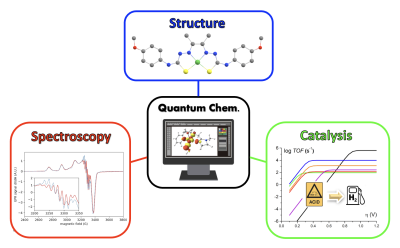Career path
Since 2024 CNRS researcher director, Aix-Marseille University
2010-2024 CNRS researcher, University of Lille 1 / Aix-Marseille University
2014 Habilitation, University of Lille 1
2009-2010 Postdoctoral position, University of Grenoble 1
2007-2009 Postdoctoral position, MPI - University of Bonn, Germany
2004-2007 PhD in Molecular, Structural and Physical Chemistry, CEA - University of Grenoble 1
Honour
- Distinguished member SCF, 2025 promotion.
Teachings
- Lectures and practicals in computational chemistry and EPR simulation (since 2008)
Research themes
My research focuses on the experimental and theoretical characterization of molecular catalysts for the activation of small molecules, with a particular interest in hydrogen production. My specificity is to use quantum chemical tools to: (i) better understand reaction mechanisms (ii) predict the catalytic performance of systems and (iii) develop new synthetic targets.
References: Chem. Eur. J., 2022 - Chem. Comm., 2021.

1) Bio-inspired hydrogen production: molecular electrocatalysis, photocatalysis and supported catalysis
By combining non-innocent ligands and Earth-abundant transition metal ions, we have developed familes of bio-inspired complexes active in electrocatalytic proton reduction. We have shown that these complexes exhibit significant activity for the reduction of protons to hydrogen. However, the key elements for understanding and improving their reactivity remain unknown. A first research line aims to predict the catalytic performance of our bio-inspired complexes to design more efficient molecular catalysts. A second axis aims to combine catalytic centers with a solid matrix, in order to design stable and sustainable electrodes. A final focus is the development of noble metal-free systems for photocatalytic hydrogen production.
Funding : ANR, ANRT, DGA, Région Sud, IEA, AMUTech
Participants: R. Hardré, B. Faure, M.Réglier
Collaborations: Company Rener, Athanassios Coutsolelos (Univ. Crete), Kalliopi Ladomenou (Univ. International Hellenic)
Publications: Chem. Eur. J., 2018 - Chem. Sus. Chem., 2019 - Dalton Trans., 2020 - RSC Adv., 2021 - Chem. Phys. Chem., 2022 - ChemCatChem, 2024 - Dalton Trans. 2025.
2) Oxygen activation: Structure-function studies of copper monooxygenases
Lytic Polysaccharide Monooxygenases (LPMOs) are copper metalloenzymes that catalyze the oxidative cleavage of recalcitrant polysaccharides. LPMOs hydroxylate a C-H bond on cellulose using a copper active site. Many questions remain as to the mode of action of the enzyme and the role of the particular coordination motif "histidine-brace". We develop structure-function relationships for these copper monooxygenases using a dual approach combining experimental data and theoretical calculations. We are developing a multidisciplinary approach combining biology, spectroscopy and quantum chemistry to interpret the structure and properties of these enzymes and better understand the reactivity of copper centers.
Fundings: ANR, PHC Procope, PHC Procope +
Participants: A. Jalila Simaan, A. Ciaccafava, M. Réglier
Collaborations: Sylvain Bertaina (IM2NP, Aix Marseille Univ.), Giuseppe Sicoli (LASIRE, Lille Univ.), Dimitrios Pantazis (MPI Mülheim, Germany)
Publications: Chem. Phys. Chem., 2020 - Magnetochemistry, 2022 - Inorg. Chem., 2022 - Inorg. Chem., 2024 - Actu. Chim., 2024.
Collaborations and groups
Collaborations
- France, Grenoble : Stéphane Torelli (LCBM)
- France, Paris : Ally Aukauloo (ICMMO), Sébastien Blanchard (IPCM)
- France, Lille : Giuseppe Sicoli (LASIRE)
- France, Marseille : Sylvain Bertaina (IM2NP)
- Germany : Dimitrios Pantazis (MPI Kofo Mülheim)
- Grece : Athanassios Coutsolelos (Univ. Crete), Kalliopi Ladomenou (Univ. International Hellenic)
- Mexico : Ivan Castillo (UNAM)
Supervisions
- Iris Wehrung, PhD student MRT 2023-2026, topic copper enzymes and models, co-supervisor: J. Simaan
- Léa Delmotte, project engineer RENER 2024-, topic hydrogen
- Miroslava Arronte Morales, PhD Mexico 2025-2026, topic copper enzymes and models, supervisors: J. Simaan / I. Castillo
- Nicolas Husson, research engineer RENER 2025-, topic hydrogen
- Matteo Bassi, Master 2 intern, 2025-2026, topic hydrogen
- Jana Mehrez, postdoc RENER 2026-, topic hydrogen
Administrative responsabilities
- Deputy director of the Infrastructure Themosia (Themosia, since 2024)
- Operational mamanger of an EPR plateform at the Infranalytics IR (Infranalytics, since 2023)
- Tresurer of the French EPR society (ARPE, since 2021)
Scientific outreach efforts
- Festival Explore AMU, Street encounters, Marseille 2024 and 2025
- Podcast CNRS Qu'est-ce que tu cherches ?: Green light for hydrogen 2024
- Written press, newspaper La marseillaise: La chimie quantique permet d’accélérer la démarche des chimistes 2019
- Article, journal Actualité chimique: Mécanismes du vivant et catalyse 2024 ; Un duo gagant pour la catalyse redox 2019
- En direct des laboratoires from CNRS Chemistry: Un catalyseur photoredox qui accumule les charges sous lumière visible 2023 ; Des composés rédox-actifs pour booster la production d’hydrogène 2018 ; Le rôle crucial du couple tyrosine/histidine dans la photosynthèse 2018 ; La bio-inspiration au secours de la production d'hydrogène 2016


